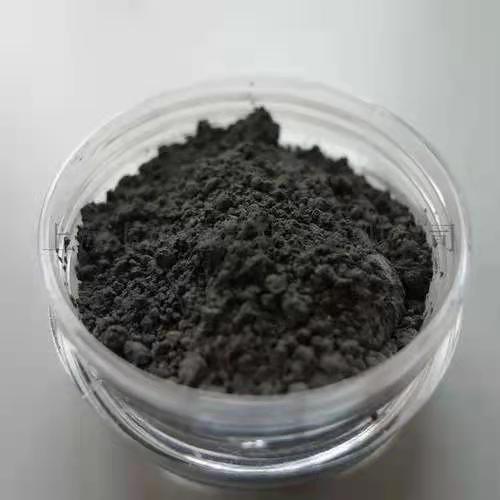Molybdenum disilicide is a silicon compound of molybdenum, also known as molybdenum silicide, with a molecular formula of MoSi2 and a molecular weight of 154.13.Since the radii of the two kinds of atoms are not much different and the electronegativity is relatively close, they have properties similar to those of metals and ceramics. The melting point is as high as 2030°C, and it is conductive. At high temperatures, a passivation layer of silicon dioxide can be formed on the surface to prevent further oxidation. Its appearance is gray metallic color, which is derived from its tetragonal α-type crystal structure. It also has a hexagonal shape but is unstable. The β-modified crystal structure. Insoluble in most acids, but soluble in nitric acid and hydrofluoric acid.

Development history
Molybdenum silicide was discovered in 1906. Under different conditions, silicon and molybdenum can form tri-molybdenum silicide, Penta-molybdenum tri-silicide, and molybdenum disilicide.
The most important of the three molybdenum silicides is molybdenum disilicide (MoSi2), which is a Dalton-type intermetallic compound. The combination of atoms in its crystal structure presents the coexistence of metal bonds and covalent bonds and has excellent high-temperature essential characteristics.
As early as 1907, molybdenum disilicide was used as a high-temperature anticorrosive coating material for metals, and molybdenum disilicide heating elements appeared in the 1950s.
Molybdenum disilicide as a structural material was first proposed in the early 1950s, but it was not taken seriously until the 1970s with the emergence of the concept of brittle materials as structural materials. In the 1980s, rapid progress took place, and its research work was widely carried out all over the world.
Physical and chemical properties of molybdenum disilicide
MoSi2 is an intermediate phase with the highest silicon content in the Mo-Si binary alloy system, and it is a Dalton-type intermetallic compound with a fixed composition. With the dual characteristics of metal and ceramics, it is a high-temperature material with excellent performance. Very good high-temperature oxidation resistance, the oxidation resistance temperature is as high as 1600℃, which is equivalent to SiC; moderate density (6.24g/cm3); low thermal expansion coefficient (8.1×10-6K-1); good electrical and thermal conductivity Properties; higher brittle-to-ductile transition temperature (1000℃) below has ceramic-like hardness and brittleness. It is metal-like soft plasticity above 1000°C. Modi is mainly used as heating elements, integrated circuits, high-temperature anti-oxidation coatings, and high-temperature structural materials.
In MoSi2, molybdenum and silicon are connected by metal bonds, and silicon and silicon are connected by covalent bonds. Molybdenum disilicide is a gray tetragonal crystal. It is insoluble in general mineral acids (including aqua regia), but soluble in a mixed acid of nitric acid and hydrofluoric acid. It has good high-temperature oxidation resistance and can be used as a heating element working in a high temperature (<1700°C) oxidizing atmosphere.
In an oxidizing atmosphere, a protective film is formed on the surface of the dense quartz glass (SiO2) that burns at a high temperature to prevent continuous oxidation of molybdenum disilicide. When the temperature of the heating element is higher than 1700°C, a SiO2 protective film is formed, which fuses at a melting point of 1710°C, and merges with SiO2 into a molten drop. Due to the action of its surface extension, it loses its protective ability. Under the action of the oxidant, when the element is used continuously, it forms a protective film again. It should be noted that due to the strong oxidation at low temperatures, this element cannot be used for a long time in a temperature environment of 400-700°C.
Application of molybdenum disilicide
Molybdenum disilicide is used in the fields of high-temperature oxidation-resistant coating materials, electric heating elements, integrated electrode films, structural materials, composite material reinforcements, wear-resistant materials, and structural ceramic connection materials, and is distributed in the following industries:
(1) Energy and chemical industry: electric heating elements, high-temperature heat exchangers of atomic reactor devices, gas burners, high-temperature thermocouples, and their protection tubes, smelting vessels, and crucibles (used for smelting sodium, lithium, lead, bismuth, tin, and other metals) ).
(2) Microelectronics industry: MoSi2 and other refractory metal silicides Ti5Si3, WSi2, TaSi2, etc. are important candidate materials for large-scale integrated circuit gates and interconnection lines.
(3) Aerospace industry: As a high-temperature anti-oxidation coating material, it has been widely and in-depth research and application. Especially as a material for turbine engine components, such as blades, impellers, combustors, nozzles, and sealing devices.
(4) Automobile industry: turbocharger rotors, valve bodies, spark plugs, and engine parts for automobiles.
Ozbo.com (aka. Tanki New Materials Co.Ltd.) is a trusted global chemical material supplier & manufacturer with over 12 years of experience in providing super high-quality chemicals and Nanomaterials. As a leading nanotechnology development and product name manufacturer, Tanki New Materials Co.Ltd dominates the market. Our professional work team provides perfect solutions to help improve the efficiency of various industries, create value, and easily cope with various challenges. If you are looking for molybdenum disilicide , please feel free to contact us.


